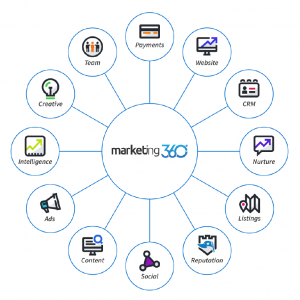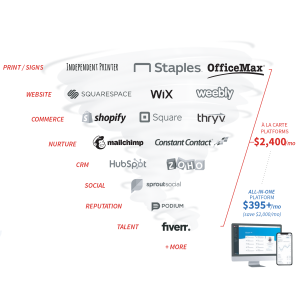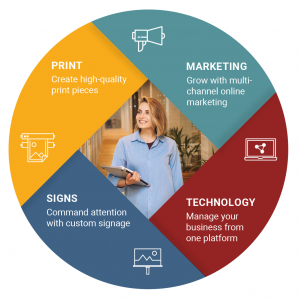Digital marketing is the lifeblood of modern businesses. Even if you’re a company that sells tangible products to buyers face to face, many of your customers will first discover you online. Having that online presence could be the only thing standing in between you and your next customer. To help you capitalize on all that digital marketing has to offer, you first need to develop a strategy to guide your marketing decisions.
By definition, a digital marketing strategy is simply the planned actions and goals to grow your business. Developing a strategy requires you to be forward-thinking about what you want to achieve and how to go about it.
Many of our
AlphaGraphics clients have a specific need or plan when they order printed signs and materials from us. For example, if you have a trade show or event coming up, you already know the types of signage, collateral, or postcards you need to promote your business. This way, you’re only spending money and time on what you really need. You know how these things will work to achieve a greater goal.
Now that we’ve partnered with
Marketing 360 to offer
digital marketing services, we recommend taking that same planned approach to your online marketing needs for 2022 and beyond.

We’re going to cover the key moving parts that should be part of your strategy and the role they play in your online success.
But first…
Why Your Business Needs a Digital Marketing Strategy
Technically speaking, you can start marketing your business online without a strategy. Make a website, buy some ads, and start posting on social media, for example. But we compare this to driving a car without knowing where you’re going. Or maybe you have a destination in mind but no route to take you there.
That’s the value of a good digital marketing strategy. Digital marketing is a broad topic, so having a strategy can help you narrow your focus on the most important priorities. Because let’s face it: you’ve got a business to run, and you likely don’t have an infinite budget or lots of people that can try every possible tactic to grow your business. It’s expensive, plus it can take you even longer to start making progress when you’re shooting in the dark instead of focusing on your best opportunities.

The best news: creating a digital marketing strategy doesn’t have to be the hefty undertaking it sounds like. Starting with the basics gives you a strong foundation you can start building on immediately ― and start seeing results almost as quickly.
Now, let’s get into the nuts and bolts of what makes a solid digital marketing strategy.
SMART Goals
Every strategy begins with an objective. Think of your goal as the destination, and the strategy is the route you take to get there. But don’t set just any goal — make sure it’s a SMART goal.
What are SMART goals, you ask?
SMART stands for Specific, Measurable, Attainable, Relevant, and Timely. Your digital marketing goals should be all of these things; if they aren’t, choose different goals.
For example, saying your goal is to increase sales isn’t SMART. Technically, increasing your sales by a dollar each month is still an increase. So by how much should sales increase before you feel like your digital marketing is worth it?
Setting a goal of getting 10 new customers isn’t great, either. How soon do you want to get those customers? Within a week? A year?
How about doubling your revenue? That’s a goal that really depends on where you’re starting. If you’re generating $5K a month in revenue, then doubling it within a few months might be feasible for you. But if you’re generating $1M a year, then doubling that within a few months might be unrealistic.
A better goal would be something like this:
“I want to increase monthly revenue from $5K to $10K within the next six months.”
That goal is specific. It’s timely because it places a deadline on the goal. It’s realistic and relevant, plus it’s a goal you can measure along the way.
When you start a digital marketing strategy with SMART goals, you can make better decisions about which levers to pull and buttons to push to reach those goals.
A Business Website
At the dawn of the digital era, websites were often viewed as a luxury that only large companies could afford. But that’s no longer the case. Websites are much easier to make and maintain, and prices for websites and hosting have decreased substantially.
Your website serves as the anchor for your entire digital marketing strategy. Consider it your digital identity. It’s the biggest piece of media you will own with your company’s name attached to it. All of your other digital marketing will stem from or circle back to your business’s website.
Your website is also where your customers will go to learn more about who you are and what you do. It will also be the place where your customers will take the next step.
For example, let’s say you set a marketing goal to grow your email subscriber list. Visitors can sign up on your website, with each sign-up representing a conversion. Or, if you want to make more sales on the spot, your ads will lead them back to your website where they can purchase.
Unlike third-party outlets like social media and search engines, your website is something you own. You have total control over how your website looks and functions. And most importantly, you control the image you present to your visitors. This is a powerful tool in building your credibility as a business and giving customers a reason to do business with you.
Search Engine Optimization
Search engine optimization, or SEO, is an essential piece of your digital strategy if you have a website. SEO is the process of optimizing your website content so that it’s easily understood by search algorithms. When these algorithms know what your website is about, you have a stronger chance of ranking higher in search results.
SEO matters to marketers because search results are free traffic. The higher you rank, the more clicks you will likely receive. Research shows that
roughly 28.5% of all clicks go to the top result. Almost all clicks go to the results displayed on Google’s Page 1. Very few people will click beyond the first page.
You can bypass the rankings and reach the very top of the results page by paying for ads. But for small businesses with smaller budgets, organic traffic is attractive because it’s essentially free.
How can you make your website SEO-friendly? There are a lot of moving parts to this process. For example:
- Use the right keywords throughout your website
- Make use of H2s
- Optimize your page load speed
- Make your website mobile-friendly
- Add meta titles and descriptions to each web page
- Include images
- Earn backlinks from other websites
- Regularly publish authoritative content
- Keep your website updated
SEO is continually evolving. Every time Google updates it algorithm, your rankings may change as a result. What’s more, if your competitors are investing in SEO, your rankings may be in constant flux. It’s important to treat SEO as an ongoing process, not a one-and-done item on your marketing checklist.
Email Marketing Tools
Email marketing remains one of the lowest-cost forms of marketing, generating as much as a 4,400% ROI. Email helps you build relationships with leads and customers. It keeps your brand top of mind and allows you to continue growing your authority in your industry. What’s more, you’re able to speak directly with your customers at a time that’s convenient for them.
Even better fur busy businesses, email marketing tools allow you to automate much of the process. Once you create your email, you can use technology to schedule emails in advance. Email automation will track important metrics like open rates, clicks, and conversions, as well as optimal send times based on engagement. Use this data to help you create stronger email campaigns over time.
How can you use email marketing to turn your website into a lead-generating machine? When people land on your website, use their visit as an opportunity to carry on the conversation after they leave. For example, you can create a pop-up form prompting people to enter their email address. Offering an incentive, such as a coupon or free piece of content, can encourage even more sign-ups.
Social Media
Social media has become a powerhouse in the digital marketing arena. One of the biggest advantages is that there are tons of ways to market yourself within the social media sphere. For example, you can pay for ads, grow your following, earn ratings and reviews, share content, contribute to discussions, and have one-to-one conversations with leads and customers.
What’s more, there are tons of unique channels to use to grow your brand and connect with your target audience. Facebook, Instagram, Pinterest, LinkedIn, and other platforms each look and function differently. They cater to different types of users and fulfill different purposes.
You don’t have to be a world-class brand to use social media for business growth. Studies show that
54% of people will use social media to research products and companies before making buying decisions.
How exactly can you use social media as part of your digital marketing strategy? Here’s the tip of the iceberg:
- Share content to create top of mind awareness
- Acquire new customers
- Build trust through ratings or reviews
- Drive traffic to your website
- Share new product announcements
- Highlight news about your company
- Feature your content, such as a video or blog post
- Gain support for a cause or initiative
There’s a lot you can do with social media. But going back to setting SMART goals, it’s essential that you prioritize your efforts based on what you want to achieve. Think about the outcomes, then choose the social media tactics that will best help you reach them.
Earned, Owned, and Paid Media
The one common denominator between your website, email marketing, social media, and SEO is content. Content is king in a digital marketing strategy because it serves as the foundation for your campaigns.
Content falls into one of three buckets: Earned Media, Owned Media, and Paid Media.
Earned media represents the free publicity you get for your business. For example, a local newspaper might run a story about your company. Or your customers might create content on your behalf. Online reviews also fall into this category. Earned media isn’t something you pay for, which makes it all the more valuable.
Owned media are assets you create yourself. You own those assets and can use them any way you like. Your website, blogs, white papers, images, videos, and social media profiles fall under this umbrella. With owned media, you have the ability to track their performance and see how well they’re working for you. For example, you can see how long people are staying on your website or how many times someone read a blog post.
Last but not least, paid media represents your digital ads, such as Google Ads, social media ads, and retargeted ads. These ads are targeted to a specific audience and channel to generate interest in your business. However, once you stop paying for these assets, they disappear from view.
Earned, owned, and paid media each serve special purposes in your digital marketing strategy. We recommend using all three in your digital marketing strategy: each one’s strengths can make up for the others’ shortcomings.
CRM
Customer Relationship Management software, or CRM, has become one of the must-have tools for any sales department. CRM organizes all of your leads, contacts, and customers into a single platform. This allows you to track all of your interactions over time, stay in touch with prospects, track sales and activities, and more.
When included in a digital marketing strategy, CRM can provide tons of value from several angles. For starters, your digital marketing will be responsible for adding new entries to your CRM. Once you capture leads, your sales team can start the process of nurturing those leads through your sales funnel and hopefully turn them into paying customers.
And once leads convert, you can continue the conversation to keep them on your side. Continue upselling or upgrading their services, cross-sell complementary products, ask for referrals, and track their total lifetime value, among other things.
CRM allows you to see at a glance your most valuable customers. See what people are buying, how frequently they’re buying, how much they’re spending, and how long they’ve been customers. Use this data to find new opportunities to increase your revenue and broaden your audience.
The Right Metrics
Going back to SMART goals, measuring the impact of your digital marketing is key to understanding your marketing’s role in your business. Goals need to be measurable so you can see whether you hit the mark. If you achieved your goal, you can look back to see what worked well for you and build on those successes. And if you didn’t achieve your goal, you can figure out what didn’t work well for you and what you might need to change moving forward.
A lot of the metrics you will want to track can be found in your CRM. For example, you can track responses to specific campaigns by documenting lead sources for each of your new customers. A quick CRM search for that lead source can show you just how effective that campaign was in terms of conversions, revenue, cost per acquisition, and total lifetime value.
Another source is Google Analytics. You can install the Google Analytics plugin on your website and allow it to track website traffic from your ad campaigns. It provides real-time feedback into your advertising ROI as well as website data, such as the number of visitors, their journey through your website, pages viewed, and more.
One caveat worth mentioning here is that you don’t have to measure everything, and you shouldn’t try. Too often, businesses that are new to digital marketing get so bogged down in the numbers that they lose sight of what those numbers mean in the grand scheme of things. We recommend choosing metrics based on your goals and measuring only the things that really matter to your success.
Get Done-For-You Digital Marketing with AlphaGraphics
Crafting a digital marketing strategy is no longer optional for modern businesses. So much of how people and businesses operate take a digital-first approach, and savvy businesses know to go where their audience already is.

At AlphaGraphics, we’re pleased to partner with Marketing 360 to bring you new ways to get ahead of your competitors and stand out in your field. We now provide comprehensive digital marketing services, from SEO to digital ad management and more. Plus, our integrated platform gives you a 360-degree view of your marketing and metrics from a single point of reference. Know with confidence what’s working in your marketing so you can grow your business the fastest and most efficient way.
Schedule an appointment, and let’s talk about your next project.